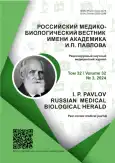Variants of Mutual Arrangement of Parts of Human Pancreas According to Computed Tomography Data
- Authors: Sekisova E.V.1, Pavlov A.V.1, Pronin N.A.1, Zherebyatyeva S.R.1, Vvedensky A.I.1, Dronova E.A.1, Poludkin I.A.1
-
Affiliations:
- Ryazan State Medical University
- Issue: Vol 32, No 3 (2024)
- Pages: 467-474
- Section: Original study
- Submitted: 17.03.2023
- Accepted: 01.06.2023
- Published: 04.10.2024
- URL: https://journals.eco-vector.com/pavlovj/article/view/321391
- DOI: https://doi.org/10.17816/PAVLOVJ321391
- ID: 321391
Cite item
Abstract
INTRODUCTION: With development of methods of diagnosis and surgical treatment of diseases of hepatopancreato-biliary region, there is increasing interest in and necessity to search for various methods of studying organs of this zone. Compared to the earlier methods of studying topographic anatomy, the method of computed tomography (KT) permits to work with a wide scope of lifetime data of human anatomy. We did not find enough information in the literature about peculiarities of the shape, size and position of pancreas in the horizontal projection.
AIM: To study the peculiarities of the shape, size and position of the pancreas using contrast-enhanced CT data.
MATERIALS AND METHODS: The work was based on the available archive of examination of organs of the abdominal cavity by CT method with contrast in patients (n = 31) without pathology of the hepatopancreatobiliary zone, gastrointestinal tract, spleen, kidneys and spine. Measurements were performed based on the horizontal projection of scans. The length was determined by measuring the organ in parts. The degree of curvature of the pancreas shape was determined by constructing the central axis of the organ and measuring the angles formed by it. The obtained data were subjected to statistical processing.
RESULTS: According to increase in the length of the organ, three groups were formed. Different degrees of the organ bending were identified. Upon that, no clear correlation was found with skeletopy data, age and gender and parametric data of the upper part of the abdominal cavity.
CONCLUSION: Owing to the developed method of measuring angles between parts of the pancreas, a range of mutual arrangement of the head and body, body and tail of the gland in the horizontal projection was obtained. Our data complement the anatomy of the pancreas and can be considered as a promising resource for further study of the features of syntopy and blood supply of the organs of the upper part of the abdominal cavity.
Keywords
Full Text
About the authors
Evgenia V. Sekisova
Ryazan State Medical University
Author for correspondence.
Email: jany.s@mail.ru
ORCID iD: 0000-0002-4629-3887
SPIN-code: 1986-1300
Russian Federation, Ryazan
Artyom V. Pavlov
Ryazan State Medical University
Email: av.pavlov-rzgmu@yandex.ru
ORCID iD: 0000-0002-8224-824X
SPIN-code: 4227-7508
MD, Dr. Sci. (Med.), Professor
Russian Federation, RyazanNikolay A. Pronin
Ryazan State Medical University
Email: proninnikolay@mail.ru
ORCID iD: 0000-0002-6355-8066
SPIN-code: 4991-0918
MD, Cand. Sci. (Med.), Associate Professor
Russian Federation, RyazanSvetlana R. Zherebyatyeva
Ryazan State Medical University
Email: pferdin@mail.ru
ORCID iD: 0000-0001-8232-2748
MD, Cand. Sci. (Med.), Associate Professor
Russian Federation, RyazanArtyom I. Vvedensky
Ryazan State Medical University
Email: ai_vvedenskiy@mail.ru
ORCID iD: 0000-0001-7880-1164
SPIN-code: 3709-6109
MD, Cand. Sci. (Med.)
Russian Federation, RyazanEkaterina A. Dronova
Ryazan State Medical University
Email: katrinpears19@yandex.ru
ORCID iD: 0000-0002-1349-3284
SPIN-code: 2263-6220
Russian Federation, Ryazan
Ivan A. Poludkin
Ryazan State Medical University
Email: mister.ivan2001@yandex.ru
ORCID iD: 0000-0001-9002-1101
Russian Federation, Ryazan
References
- Revishvili ASh, Kriger AG, Vishnevskiĭ VA, et al. Current issues in pancreatic surgery. Pirogov Russian Journal of Surgery. 2018;(9):5–14. (In Russ). doi: 10.17116/hirurgia20180915
- Patiutko IuI, Kudashkin NE, Kotel'nikov AG. Hepatopancreatoduodenal resection — are there any perspectives? Pirogov Russian Journal of Surgery. 2011;(8):41–6. (In Russ).
- Kalinin RE, Natal’skiy AA, Zherebyat’yeva SR, et al.; Kalinin RE, editor. Klinicheskaya anatomiya podzheludochnoy zhelezy. Ryazan’: RyazGMU; 2021. (In Russ).
- Prives MG, Lysenkov NK, Bushkovich VI. Anatomiya cheloveka. 13th ed. Moscow: GEOTAR-Media; 2022. (In Russ).
- Renard Y, de Mestier L, Perez M, et al. Unraveling Pancreatic Segmentation. World J Surg. 2018;42(4):1147–53. doi: 10.1007/s00268-017-4263-5
- Zenin OK, Kalmin OV. Sposob sokhraneniya biologicheskogo materiala. Vestnik Penzenskogo Gosudarstvennogo Universiteta. 2016;(1):22–6. (In Russ).
- Pikalyuk VS, Moroz GA, Kutya SA. Metodicheskoye posobiye po izgotovleniyu anatomicheskikh preparatov. Simferopol’; 2004. (In Russ).
- Zhou ZM, Fang CH, Huang LW, et al. Three dimensional reconstruction of the pancreas based on the virtual Chinese human — female number 1. Postgrad Med J. 2006;82(968):392–6. doi: 10.1136/pgmj.2005.039230
- De Molo C, Cui XW, Pirri C, et al. Pancreas mobile. Z Gastroenterol. 2013;51(10):1165–70. doi: 10.1055/s-0033-1335185
- Gayvoronsky IV, Bykov PM, Gayvoronskaya MG, et al. The variant anatomy of the celiac trunk and its branches in adult men and women with various body shapes. Morphological Newsletter. 2020;28(2):32–40. (In Russ). doi: 10.20340/mv-mn.2020.28(2):32-40
- Kagan II. Current aspects of clinical anatomy in the 21 century. Russian Journal of Operative Surgery and Clinical Anatomy. 2018;2(4): 33–40. (In Russ). doi: 10.17116/operhirurg2018204133
- Safronova YV, Chemezov SV. General regularities of changes in the topography of the pancreas after nephrectomies. Modern Problems of Science and Education. 2016;(2):10-10. Available at: https://science-education.ru/ru/article/view?id=24157. Accessed: 2023 March 17. (In Russ).
- Kagan II, Tretyakov AA, Chemesov SV, et al. Topographo-anatomical charges after resection of oesophagus, pneumonectomy, nephrectomy. Orenburg Medical Herald. 2016;4(3):23–7. (In Russ).
- Sergiyevich EG. Variantnaya anatomiya podzheludochnoy zhelezy vzroslogo cheloveka po dannym komp’yuternoy tomografii. Young Scientist. 2018;(42, Pt 1):34–6. (In Russ).
- Kolmannskog F, Swensen T, Vatn MH, et al. Computed tomography and ultrasound of the normal pancreas. Acta Radiol Diagn (Stockh). 1982;23(5):443–51. doi: 10.1177/028418518202300502
- Kagan II. Clinical anatomy in modern morphology and medicine. Medical Education and Professional Development. 2011;(2):27–35. (In Russ).
Supplementary files












